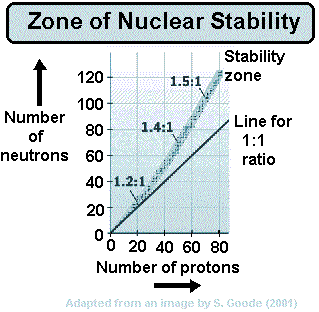    |
||||
 Why
radioactivity occurs Why
radioactivity occurs |
||||
|
If all of the isotopes are plotted on a chart we find that there is a general trend for those that are stable and those that are unstable lie outside the zone of nuclear stability (rather like a 'line of best fit'). See this page for more information and larger graphs.
The stability zone follows the 1:1 ratio for the first 20 elements, and then an increasing number of neutrons to protons are needed if the nuclide is to be stable.
and gamma radiation is often found to accompany or follow emission of radiation of the other types. When radioactive decay occurs the mass of the products of the decay is less than the mass of the parent radioisotope. This 'missing mass' can be converted into 'missing energy' that is realised as kinetic energy of the product particles. It is given the symbol Q
Using Einstein's equation linking mass and energy (remember that 'c' is the speed of all electromagnetic energy in a vacuum) we can calculate the energy equivalents of the masses involved and work out the kinetic energy of the products formed.

Because of the number of significant figures we are required to work to in such calculations a mass/energy equivalent value is given in the data book
A worked example of a typical question is given for you to look at. When a product is formed it is rarely stable itself and undergoes further decay. This is summarised in the decay series. |
||||
 |
||||




